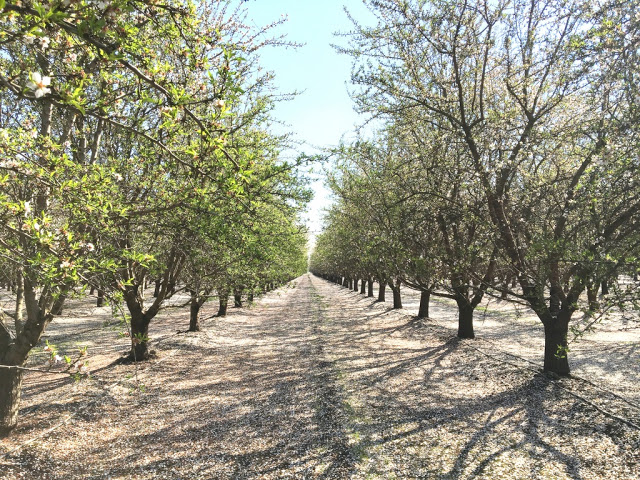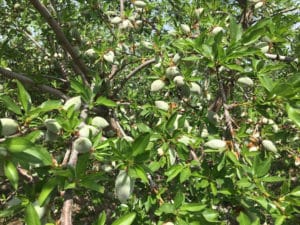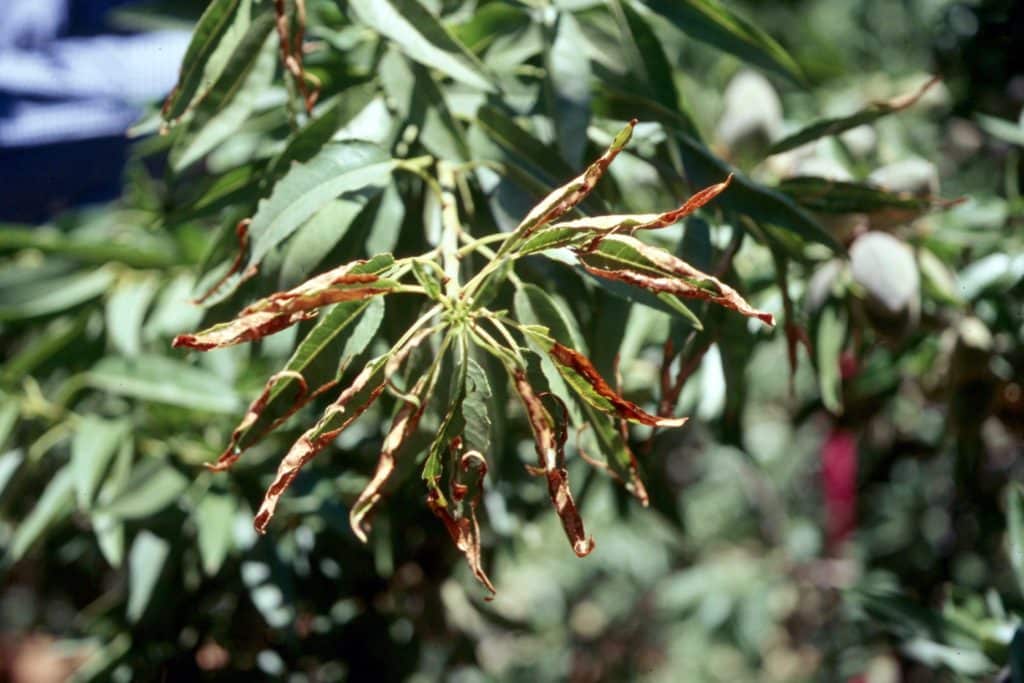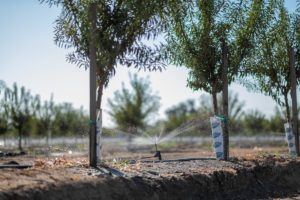
For every 1,000 pounds of almond kernels harvested, around 80 pounds of potassium (as K2O5) leaves the soil. This places enormous nutrient demands on the soil, year after year. Without additional nutrients, potassium deficiency can quickly affect yield and the health of the almond grove. However, many almond tree potassium fertilizer products also damage the health of the soil by leaving residual salts and chlorides while tying up nutrients. It is possible to restore potassium in the soil and even correct potassium deficiencies throughout the year using an agile almond tree fertilizer that is easy to apply.
Almond Tree Fertilizer Restoring Potassium Without Soil Damage
How Much Potassium is Available to My Almond Trees?
 Although most soils contain large amounts of potassium, relatively small amounts of it are in a form plants can use. Consequently, growers should base management decisions on how much potassium is available when the plants need it, rather than on how much potassium is available in the soil.
Although most soils contain large amounts of potassium, relatively small amounts of it are in a form plants can use. Consequently, growers should base management decisions on how much potassium is available when the plants need it, rather than on how much potassium is available in the soil.
Each almond orchard is a unique environment, and different soil types hold varying amounts of potassium and release it differently. This can make it tricky to manage K effectively.
“Growers who want to maximize yields need to stay on top of their K applications,” says David Doll, University of California Cooperative Extension nut pomology farm advisor for Merced County. “Otherwise, deficiencies will reduce return bloom and decrease spur longevity, which affects yields over time.”
Potassium uptake in almonds is linear, with as much as 70 to 80% of total uptake complete by mid-June. This means continuous potassium supplements will support the almond tree’s growth throughout the growing season, stimulating the growth of fruiting wood, more buds, and improved harvests. Different soil types present different challenges for maintaining potassium levels. Sandy soils and sandy loams cannot retain potassium as well as others, and require smaller, more frequent almond tree fertilizer applications. Heavier soils like clay hold on to nutrients longer, and don’t need as many applications.
Do My Almond Trees Have a Potassium Deficiency?

Deficiencies develop gradually over time and visual symptoms can take years before they show up. Plants lacking in potassium often show delayed or stunted growth. Other deficiency signs include inward curling of leaves, discolored leaf tips and marginal scorching. When severe, potassium deficiencies can increase the loss of fruiting wood, which results in reduced crop loads.
Continued monitoring and fertilization in the orchard helps growers build and maintain K at levels where deficiencies are less of a concern. Regular soil testing can help almond growers identify nutrient trends over time. Additionally, annual leaf samples help growers keep track of K levels.
“Mid-July leaf samples work well because tissue levels are relatively stable at that time of year,” says Doll. “Take two to three leaves from five non-fruiting spurs for at least 15 to 20 trees across the block. Trees should be 100 feet apart. To maintain sufficient levels across the orchard, UC Davis recommends shooting for a target potassium level of 1.6 to 1.8 percent.
Flexible Application Methods for Almond Tree Fertilizers
 Maintaining optimal potassium levels for almonds requires almond tree fertilizer treatments at harvest and throughout the year. Almond tree fertilizers with multiple application options give growers the flexibility to accomplish this.
Maintaining optimal potassium levels for almonds requires almond tree fertilizer treatments at harvest and throughout the year. Almond tree fertilizers with multiple application options give growers the flexibility to accomplish this.
AgroLiquid fertilizers can be applied in many different ways. They can even be used in combination with each other or with other crop protection products, so they can be quickly and easily applied.
With the ability to mix our almond tree fertilizer with other crop protection products, you reduce the time and energy needed to feed your trees. This way, you can grow more almonds with larger size and higher quality, without adding extra tasks.
Almond Tree Fertilizer Products to Maintain Potassium and Soil Health
AgroLiquid has formulated high-efficiency liquid fertilizer for almonds to sustain the almond tree’s linear use of potassium throughout the season. Unlike other almond tree fertilizers, ours is chloride- and hydroxide-free, so it supports soil health, long-term sustainability, and won’t upset the soil’s salt index.
 Sure-K is a chloride- and hydroxide-free potassium fertilizer ideal for supporting orchards with high potassium requirements, like almonds. With a neutral pH, Sure-K helps to protect the health and longevity of the soil, while supplying essential potassium. It can be applied as a topdress, sidedress, foliar, or through fertigation, and it can be used with many crop protection products.
Sure-K is a chloride- and hydroxide-free potassium fertilizer ideal for supporting orchards with high potassium requirements, like almonds. With a neutral pH, Sure-K helps to protect the health and longevity of the soil, while supplying essential potassium. It can be applied as a topdress, sidedress, foliar, or through fertigation, and it can be used with many crop protection products.
 Kalibrate is similar to Sure-K, but supplies sulfur in addition to potassium. Similar to Sure-K, Kalibrate is chloride- and hydroxide-free, and it can be applied in a variety of ways. Kalibrate is ideal as an early-season potassium fertilizer to stimulate strong initial growth and production.
Kalibrate is similar to Sure-K, but supplies sulfur in addition to potassium. Similar to Sure-K, Kalibrate is chloride- and hydroxide-free, and it can be applied in a variety of ways. Kalibrate is ideal as an early-season potassium fertilizer to stimulate strong initial growth and production.
 PrG provides a full array of macronutrients, including nitrogen, phosphorus and potassium, as well as iron. PrG is ideal for trees that have not yet reached maturity. PrG is also ideal for stimulating growth and speeding up reproduction at the start of the season.
PrG provides a full array of macronutrients, including nitrogen, phosphorus and potassium, as well as iron. PrG is ideal for trees that have not yet reached maturity. PrG is also ideal for stimulating growth and speeding up reproduction at the start of the season.
Let Us Design an Almond Tree Fertilizer Plan for You
The ideal AgroLiquid almond fertilizer plan is dependent on your location, climate, soil conditions, and goals with your crop. All of our fertilizer programs begin with a review of your soil samples and consultation with one of our expert agronomists. After our analysis, our team will provide you with a couple options that will help you meet your goals on a budget that won’t break the bank. Talk to an agronomist to get started.

